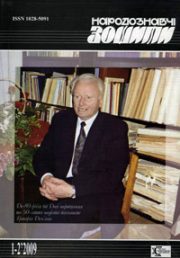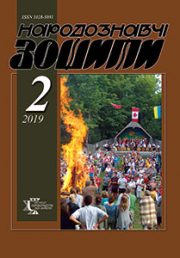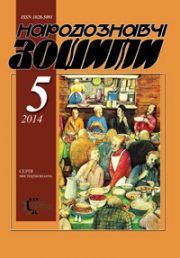The Ethnology Notebooks. 2020. № 3 (153), 605—613
UDK 398.8:[821.161.2:821.162.1]”20″
DOI https://doi.org/10.15407/nz2020.03.605
KHARCHYSHYN Olga
ORCID ID: https://orcid.org/0000-0002-9379-8300
Candidate of Philological Sciences (Ph. D. in Philology),
Senior Researcher at the Ethnology Institute
of The National Academy of Sciences of Ukraine,
15, Svobody Avenue, 79000, Lviv, Ukraine
Contacts: е-mail: okharchyshyn@gmail.com
Abstract. This article highlights Ukrainian-Polish mutual influences in songs of literary origin through the prism of exploring different forms of stylization as contemporary practices of preserving, promoting and developing traditional cultures. The relevance of the research is caused by the emphasized attention of modern science and society to the problems of ethnocultural borders, in particular, Ukrainian-Polish, and to the transformation processes in folk traditions.
The object of study is Ukrainian and Polish songs of literary origin, and the subject is their transformational forms — the so-called stylizations. The main source base is the songs posted in modern book publications and online resources (YouTube, etc.). In the proposed article we aim to trace the place and role of Ukrainian-Polish folk-song stylings in the Ukrainian-Polish folk-song interaction, to reflect the different forms of these stylings. It is found that Ukrainian-Polish songs of literary origin actively use such forms of stylization as translations, chants, allusions, etc. An effective way to extend the life of traditional work is to bring it to the art of cinema. Then, this work acquires new topical accents. It is traced how, in interaction with the neighbouring ethnoculture, the artistic qualities of the works become more expressive. The story of the transformation of the song «Hey, sokoly!» demonstrates multilevel stylizations, which are manifested not only in the texts but also in the ideological implications and various contextual readings. Various forms of folk stylistics in the modern joint repertoire of Ukrainians and Poles testify the development of both ethnotraditions along the lines of close neighbourly relations and common cultural formation. The article is based on methodological principles of a comprehensive study of folklore, taking into account interdisciplinary approaches and textual contextual relations. Such principles are laid down in the works of Ivan Franko, Filaret Kolessa, Roman Kyrchiv, Hryhoriy Nudha, Sofia Hrytsa and other researchers.
Keywords: stylizations of folk songs, song, lyrics, variant, occurrence, popularity, meaning.
Received 19.05.2020
REFERENCES
Nudha, H. (1997). Ukrainian thought and song in the world (Book 1, pp. 61—98). Lviv [in Ukrainian].
Kyrchiv, R. (2013). Studios from the Ukrainian-Polish Ethnocultural Border. Lviv [in Ukrainian].
Kyrchiv, R. (2017). The history of Ukrainian folklore studies (Vol. 1). Preromantic and romantic folklore studies. Lviv [in Ukrainian].
Kharchyshyn, O. (2018). The Cossack theme in the ethnocultural songs of Ukrainians and Poles. The Ukrainian border: the variability of traditional culture. Odessa Ethnographic Readings. Collection of scientific works. Odessa [in Ukrainian].
Kharchyshyn, O. (2018). Carols from the «Bohohlasnyk» (1790): the functioning in Ukrainian and Polish etnocultures. The Ethnology Notebooks, 6 (144), 1448—1455 [in Ukrainian].
Kharchyshyn, O. (2019). «Hey, sokoly!» («Hey, sokoіy!»): lyrics and contexts of the song. The Ethnology Notebooks, 5 (149), 1246—1259 [in Ukrainian].
Boyko, V. & Omelchenko, A. (Eds.). (1978). Songs of literary origin. Kyiv: Naukova Dumka [in Ukrainian].
If I had a guitar. Lyrics. Retrieved from: https://www.tekstowo.pl/piosenka,biesiadne,gdybym_mial_gitare. (Last accessed:18.11.2019) [in Polish].
If I had a guitar. Retrieved from: https://www.youtube.com/watch?v=lHR-XkpdkBU&list= PLHGFa30buWaLYfG-lYiG6XetnGLdH0fd4&index=11 (Last accessed: 18.11.2019) [in Polish].
Bernard Ladysh. Mother, I know. Retrieved from: https://www.youtube.com/watch?v=e2yvjatUjpY (Last accessed: 18.11.2019) [in Polish].
Kharchyshyn, O. (2011). Ukrainian song folklore in Lviv ethnoculture: transformational processes, intercultural borders. Lviv: Institute of Etnology National Academy of Sciences of Ukraine [in Ukrainian].
Masters. My wife. Retrieved from: https://www.youtube.com/watch?v=J8t9d4TIVHQ (Last accessed: 22.11.2019) [in Polish].
My wife. Lyrics. Retrieved from: https://www.tekstowo.pl/piosenka,masters,zono_moja.html (Last accessed: 22.11.2019) [in Polish].
My wife. Retrieved from: https://www.pisni.org.ua/songs/ 7256262.html (Last accessed: 22.11.2019) [in Ukrainian].
My wife. Ukrainian wedding song. Retrieved from: https://www.youtube.com/watch?v=v7OjdH2qlb8 (Last accessed: 22.11.2019) [in Ukrainian].
Sofia Rotaru. One guelder rose. Retrieved from: https://www.youtube.com/watch?v=8WHlUTsXQD8 (Last accessed: 22.11.2019) [in Ukrainian].
Ivan Komarenko. House on the Vistula bank. Retrieved from: https://www.youtube.com/watch?v=n9kppKlCMqY (Last accessed: 22.11.2019) [in Polish].
House on the Vistula bank. Lyrics. Retrieved from: https://www.tekstowo.pl/piosenka,ivan_komarenko,dom_na_wislanym_brzegu.html (Last accessed: 25.11.2019) [in Polish].
Maksymovych, M. (Ed.). (1834). Ukrainian folk songs (Vol. 1, book 2). Moscow [in Ukrainian].
Nudha, H. (1999). Cossack. Philosopher. Poet. Lviv [in Ukrainian].
He met a Cossack wonder girl. Retrieved from: https://www.tekstowo.pl/piosenka,bayer_full,lepiej_bylo_nie_czarowac.html (Last accessed: 25.11.2019) [in Polish].
Bayer Full. It was better, it was better. Retrieved from: https://www.youtube.com/watch?v=RnxUxOQrTjo (Last accessed: 25.11.2019) [in Polish].
«Never» (Ukrainian version of a 1930s Polish tango). Retrieved from: https://www.youtube.com/watch?v= zuKDDzthWj4 (Last accessed: 25.11.2019) [in Ukrainian].
Tramps. Only in Lviv. Retrieved from: https://www.youtube.com/watch?v=AlYazVircaQ. (Last accessed: 25.11.2019) [in Polish].
Viktor Morozov and the batman band «Galicia».
Retrieved from: https://www.youtube.com/watch?v= fNnXFmKKNBM (Last accessed: 25.11.2019) [in Ukrainian].
Only in Lviv. Przhemyslaw Maiewski.
Retrieved from: https://www.youtube.com/watch?v= 397XU4jEJ4E (Last accessed: 25.11.2019) [in Polish].
Galchak, B., & Kharchyshyn, O. (2019). Where do «sokoly» come from? Reflections on the genesis of a popular song. Retrieved from: http://uamoderna.com/md/halczak-kharchyshyn-hei-sokoly?fbclid=IwAR16xdLQZ6N4FityHEtOk2BekmybeDup5jEEB2zdDCaiIFDxupsmBMAPazU (Last accessed: 25.11.2019) [in Ukrainian].
Oleh Skrypka. «Hey Sokoly». Ukrainian interpretation of the soundtrack to the film «Mezha» («Borderline»). Retrieved from: https://www.youtube.com/watch?v= jCIGtPRmJmU (Last accessed: 25.11.2019) [in Ukrainian].







